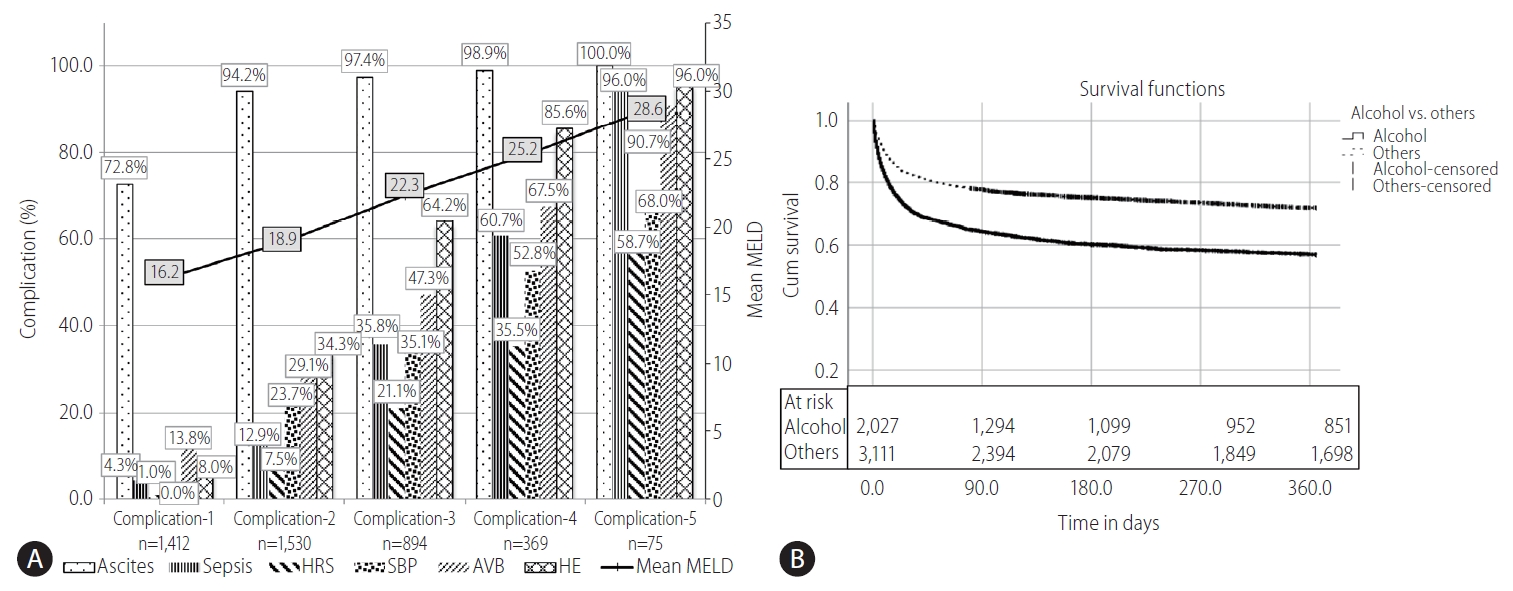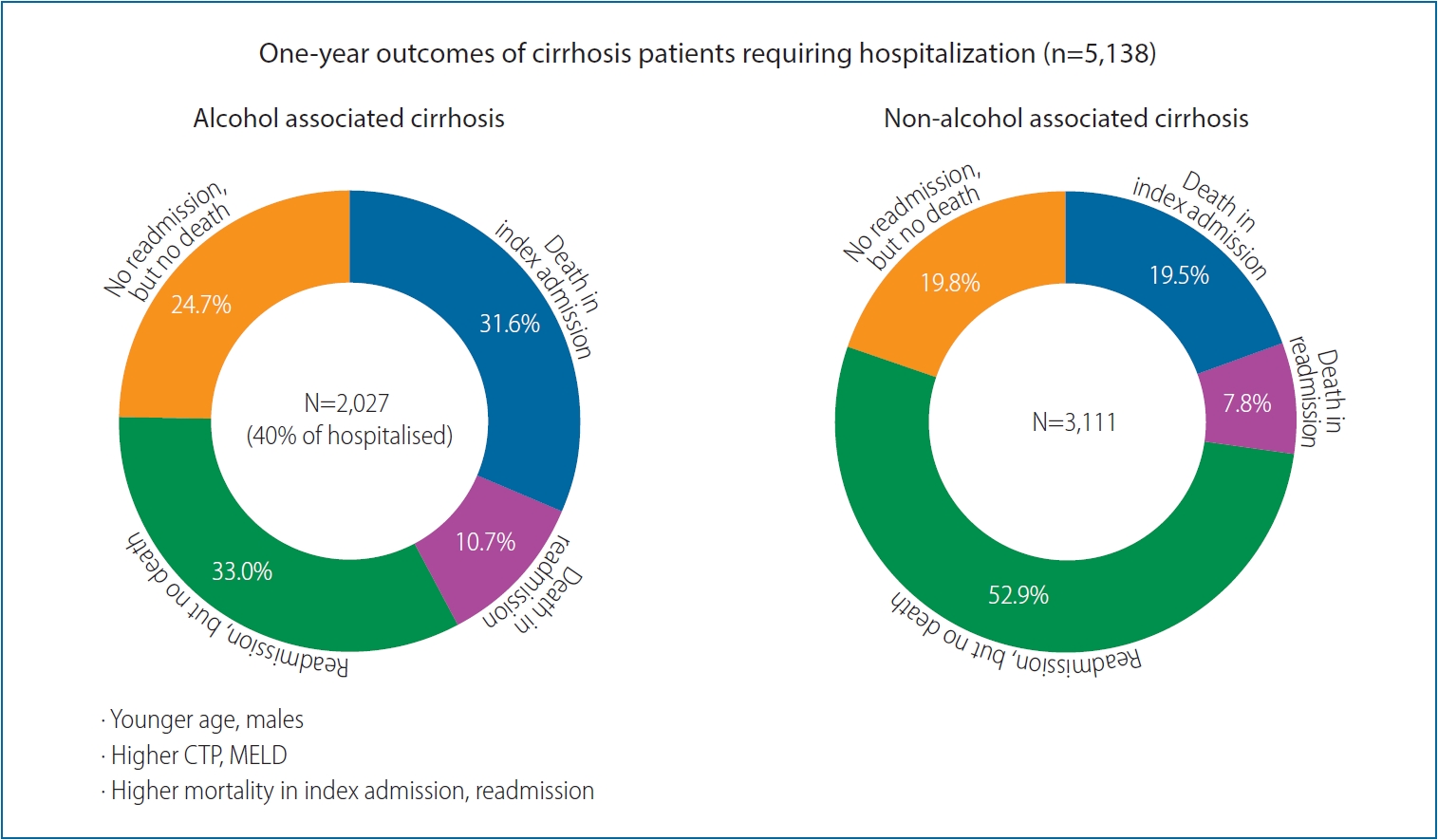| Clin Mol Hepatol > Volume 27(1); 2021 > Article |
|
ABSTRACT
Background/Aims
Methods
Results
FOOTNOTES
Figure 1.

Figure 2.

Figure 3.

Table 1.
Table 2.
| Variable | Incidence risk ratio* | 95% CI | P-value |
|---|---|---|---|
| Year of admission | |||
| 2010 | Ref. | ||
| 2011 | 1.59 | 1.23–2.06 | <0.001 |
| 2012 | 2.30 | 1.81–2.91 | <0.001 |
| 2013 | 1.95 | 1.54–2.46 | <0.001 |
| 2014 | 2.30 | 1.82–2.90 | <0.001 |
| 2015 | 2.11 | 1.66–2.67 | <0.001 |
| 2016 | 2.96 | 2.33–3.76 | <0.001 |
| 2017 | 2.58 | 2.02–3.28 | <0.001 |
| Age bracket (years) | |||
| <40 | Ref. | ||
| 41–50 | 1.15 | 1.00–1.33 | 0.06 |
| 51–60 | 1.11 | 0.96–1.27 | 0.15 |
| >60 | 1.21 | 1.10–1.34 | 0.03 |
| Gender | |||
| Female | Ref. | ||
| Male | 1.36 | 1.20–1.54 | <0.001 |
| Etiology | |||
| Alcoholic | 1.88 | 1.71–2.07 | <0.001 |
| HBV | 0.76 | 0.66–0.89 | <0.001 |
| HCV | 0.61 | 0.52–0.72 | <0.001 |
| NASH | 0.72 | 0.63–0.82 | <0.001 |
| Autoimmune | 0.61 | 0.49–0.75 | <0.001 |
| Cryptogenic | 0.81 | 0.71–0.93 | 0.004 |
| Complication | |||
| Ascites | 2.40 | 2.11–2.73 | <0.001 |
| Sepsis | 4.50 | 4.07–4.97 | <0.001 |
| HCC | 0.87 | 0.74–1.02 | <0.001 |
| HRS | 2.58 | 2.27–2.94 | <0.001 |
| SBP | 1.92 | 1.72–2.14 | <0.001 |
| AVB | 1.30 | 1.17–1.44 | <0.001 |
| HE | 3.81 | 3.45–4.19 | <0.001 |
| Severity score | |||
| CTP >10.5 | 6.34 | 5.60–7.10 | <0.001 |
| MELD >19.0 | 6.30 | 5.50–7.20 | <0.001 |
CI, confidence interval; Ref., reference; HBV, hepatitis B virus; HCV, hepatitis C virus; NASH, nonalcoholic steatohepatitis; HCC, hepatocellular carcinoma; HRS, hepatorenal syndrome; SBP, spontaneous bacterial peritonitis; AVB, acute variceal bleed; HE, hepatic encephalopathy; CTP, Child-Pugh; MELD, model for end-stage liver disease.
Table 3.
Values are presented as mean±standard deviation or number (%).
ALD, alcoholic liver disease; HBV, hepatitis B virus; HCV, hepatitis C virus; NASH, nonalcoholic steatohepatitis; HCC, hepatocellular carcinoma; HRS, hepatorenal syndrome; SBP, spontaneous bacterial peritonitis; AVB, acute variceal bleeding; HE, hepatic encephalopathy; CTP, Child-Pugh; MELD, model for end-stage liver disease.
Abbreviations
REFERENCES
- TOOLS
-
METRICS

- ORCID iDs
-
Shiv Kumar Sarin

https://orcid.org/0000-0002-0544-5610 - Related articles




 PDF Links
PDF Links PubReader
PubReader ePub Link
ePub Link Full text via DOI
Full text via DOI Full text via PMC
Full text via PMC Download Citation
Download Citation Print
Print



